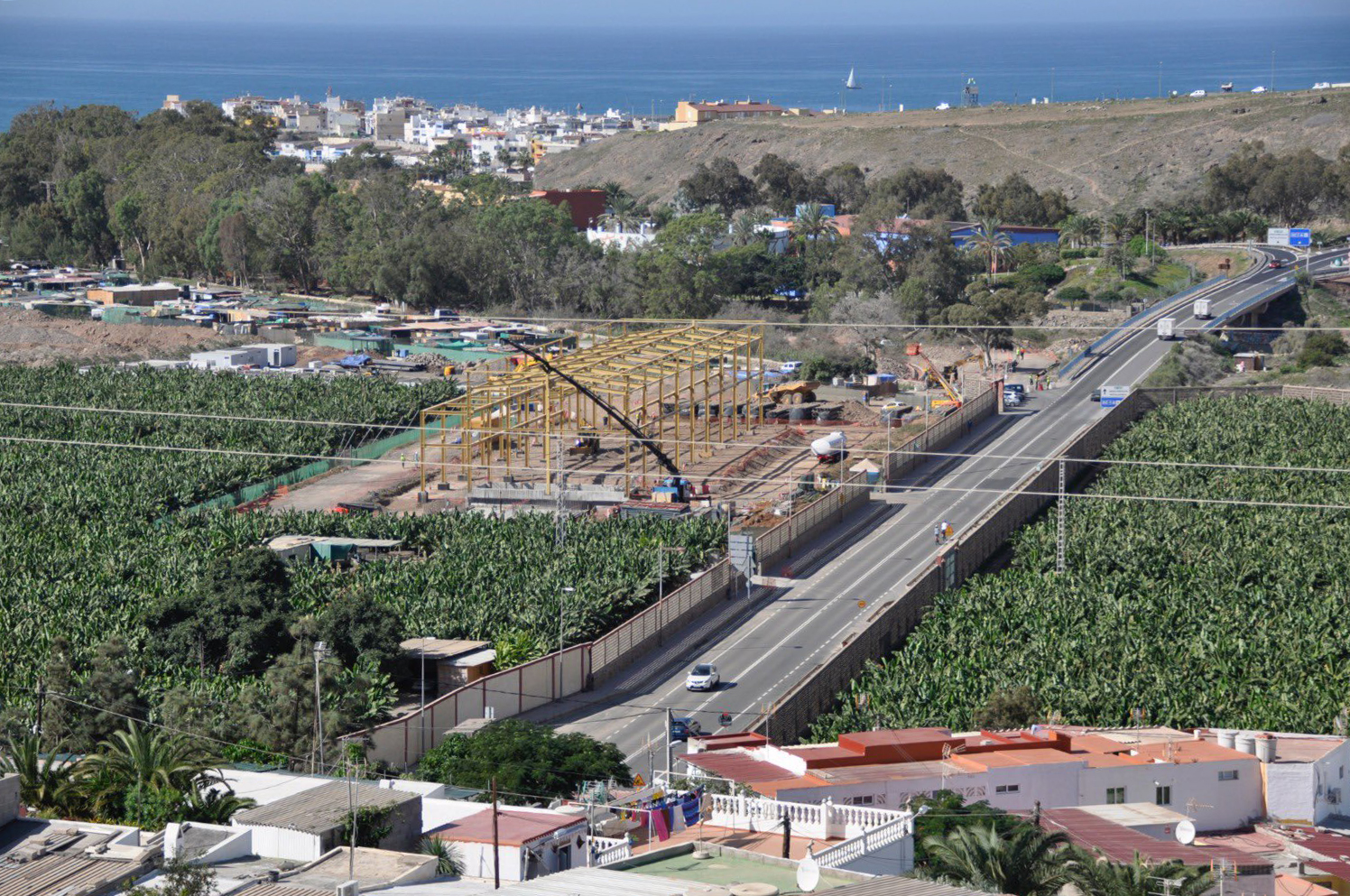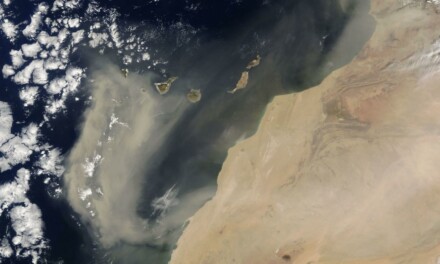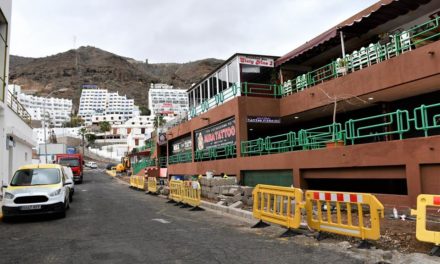The new Salto de Chira hydroelectric power station project broke ground this year, after nearly 2 decades of planning, with works now being prepared on the primary wall of the Soria dam (the largest in The Canary Islands) and its surroundings, where a spillway will be constructed to facilitate access via a service road to install elements such as water intake, the hydraulic circuit along with a secondary tunnel which will be installed.
 A protest group, Salvar Soria-Chira, backed by various ecology organisations, have voiced strong opposition to the project and on several occasions been denied grounds on which to stop the project, despite various claims of the irreparable damage to the natural environment the works are likely to cause, including the potential to wipe out endangered species, only found in this small geographical area, such as the rare, and unique, Arguineguín Flat Snail (Monilearia arguineguinensis). They also claim that not only is the technology obsolete, but that the desalinated water will not be suitable for agricultural usage, unless it is mixed with fresh water. There is serious concern about the loss of a unique habitat and the potential for further harm due to possible concentrations of phytotoxics (chlorine, sodium, boron) that may result from storing large amounts of desalinated water in an uncovered repository, caused by evaporation.
A protest group, Salvar Soria-Chira, backed by various ecology organisations, have voiced strong opposition to the project and on several occasions been denied grounds on which to stop the project, despite various claims of the irreparable damage to the natural environment the works are likely to cause, including the potential to wipe out endangered species, only found in this small geographical area, such as the rare, and unique, Arguineguín Flat Snail (Monilearia arguineguinensis). They also claim that not only is the technology obsolete, but that the desalinated water will not be suitable for agricultural usage, unless it is mixed with fresh water. There is serious concern about the loss of a unique habitat and the potential for further harm due to possible concentrations of phytotoxics (chlorine, sodium, boron) that may result from storing large amounts of desalinated water in an uncovered repository, caused by evaporation.The commemorative act to officially start work was held las February 17 at Infecar, led by Spain’s Minister of Ecological Transition and Demographic Challenge, Teresa Ribera, the Salto de Chira project has until now been focused on the construction of the Santa Águeda desalination plant, at the mouth of the Arguineguín ravine.
The first works to be completed are for a water treatment plant sending pipes up through the valley to transport desalinated water from the coast up to the Soria dam, and from there up to the Chira dam. If the deadlines are met, the Santa Águeda plant (feature image), being built by the company, Tedagua, should be finished in about 16 months, before the summer of 2024, and it will be able to pump 7,800 cubic meters a day to the inland reservoirs.
In parallel, the Soria reservoir is being prepared and conditioned, to store that water for the future and to build a pumping station. “The spillway of the Soria dam that gives access to the surface intake, hydraulic circuit and secondary tunnel” explained sources from multinational Red Eléctrica de España (REE).
 Caverns and tunnels
Caverns and tunnels
REE have awarded these works to a joint venture headed by the company Dragados, due to take 56 months. Apart from the hydraulic circuit and the secondary tunnel, this consortium of companies will also be in charge of the construction of a cavern where the pumping plant will be located, the auxiliary tunnels and the outdoor civil works.
The work on the Soria reservoir to accommodate the new hydroelectric plant will require its being emptied of all the stored water currently in it, so as to undertake works to the lower parts of the structure. That work is currently possible because the reservoir is practically empty. After years of drought on the southern half of the island, the accumulated volume held at the last measurement, carried out on December 1, stands at around 54,320 cubic meters, less than 1% of its total capacity. In the event that it rains, the plan is to divert water runoff to other deposits nearby.
Last September, after tropical storm Hermine, 98,016 cubic meters flowed into Soria, raising the stored volume of water to 211,777 cubic meters, 2% of its capacity, but most of that amount, 157,457 cubic meters, was used in October or it was diverted to other reservoirs through the Trasvasur channel, a 60km hydraulic pipe system that connects the southern reservoirs together.
The Soria dam has a theoretical capacity of 32 million cubic meters, more than all the other reservoirs on the island combined, but it has never held more than a maximum record of 12.9 million.
The works for the Salto de Chira plant are expected to last 70 months in total and generate more than 4,300 jobs, of which more than 3,500 are here on the island of Gran Canaria, as was announced by REE during the inauguration. The original investment announced was just over €400 million, however REE has subsequently recalculated the final budget for the work will increase to €618 million due to the current rise in prices.
El Salto de Chira, says the electricity operator, “will reinforce the guarantee of supply for Gran Canaria and increase integration of renewable energies into the system, it is estimated that by 2026 it will be able to increase production from these types of sources by 37% and reduce CO2 emissions by 20%”.
The Salto de Chira plant, which has been declared of general interest by the Government of the Canary Islands, takes advantage of the existence of these two large reservoirs at the summits, located at the confluence of the municipalities of San Bartolomé de Tirajana, Mogán and Tejeda, to build between them a 200 megawatt pumped hydroelectric plant, equivalent to approximately 36% of Gran Canaria’s peak demand, and 3.5 gigawatts/hour of storage. 91% of the infrastructures, say REE, will be located underground.
For its part, the Cabildo de Gran Canaria has announced that the desalinated water that reaches both dams will also be used for agricultural irrigation in other areas around the summits and the north through the creation of a piped network.
Public dams at 25% of their capacity
Gran Canaria, with its 69 reservoirs, is the territory with the highest concentration of dams in the world. The Cabildo de Gran Canaria is responsible for seven large reservoirs which currently store 2.6 million cubic meters of agricultural irrigation water, 25% of their capacity, or 11% if the semi-public Soria reservoir were included, even when it is practically empty. After two years of drought, the last water inflow was recorded during the tropical storm Hermine, about 810,000 cubic metres. However, these rains did not prevent concern in the south, where the largest dam, Chira, currently only has 710,000 cubic meters, 13% of its capacity. Ayagaures is at 23%, La Gambuesa at 62%, Fataga at 10% and El Mulato at 45%. In the northern basins, the La Candelaria reservoir has reserves at 34% of its capacity and ElVaquero is at 45%.













